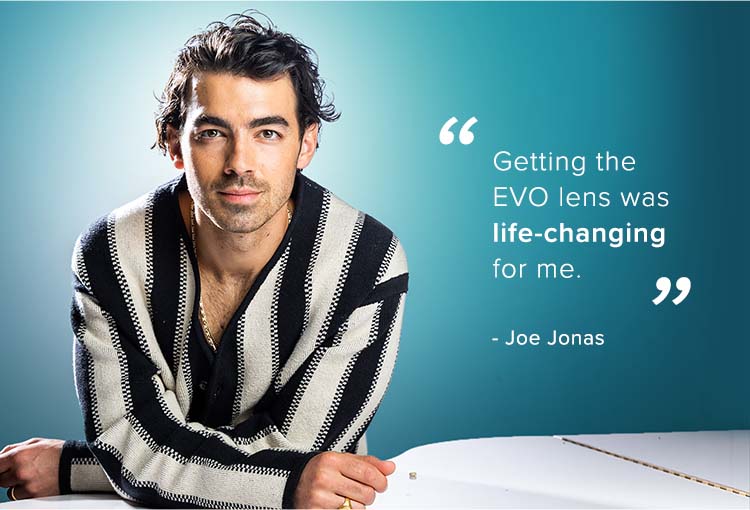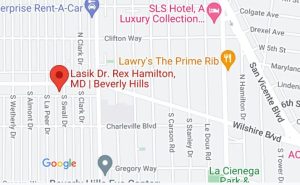If glasses and contacts no longer fit your lifestyle—but you’ve been told you’re not a candidate for LASIK—EVO ICL may be the right option for you. This advanced, additive procedure corrects nearsightedness and astigmatism from inside the eye, offering sharp, stable vision without removing corneal tissue.
Whether you have thin corneas, struggle with dry eye, or simply want a long-term alternative to contact lenses, EVO ICL offers new possibilities. Dr. Rex Hamilton provides personalized vision correction in Beverly Hills for patients throughout Los Angeles and LA, helping them see clearly and live fully.
What is EVO ICL?
EVO ICL is a breakthrough vision correction procedure that uses an Implantable Collamer™ Lens to treat moderate to severe myopia (nearsightedness) and astigmatism. Unlike LASIK or SMILE, which reshape the cornea using a laser, EVO ICL adds a thin, flexible lens to your eye—without removing any corneal tissue. This FDA-approved, phakic lens sits between the iris and your natural lens, working with your eye’s anatomy to deliver sharp, stable vision.
Because EVO ICL leaves the natural lens intact, it’s an excellent option for people with thin corneas, dry eye syndrome, or those who aren’t ideal candidates for laser eye surgery. The lens is made of biocompatible Collamer, a material that contains collagen and integrates naturally with the eye while offering built-in UV protection. It’s also removable, giving patients more flexibility than permanent procedures.
With high patient satisfaction and the potential for clearer night vision, EVO ICL is changing how people approach vision correction—offering long-term clarity without glasses or contact lenses.
Take Our LASIK Candidacy Quiz!
What Our Patients Say


What is EVO ICL™? What to Expect?
Discover the seamless synergy of EVO ICL™, a revolutionary vision solution crafted from biocompatible Collamer. Dr. Hamilton performs the painless procedure under IV or oral sedation, ensuring your comfort as drops are applied to numb the eyes and dilate your pupils. With a small, self-sealing corneal opening, the EVO ICL™ is delicately positioned to correct myopia and astigmatism without removing any corneal tissue. Each eye typically takes just 5-10 minutes, offering immediate vision improvement and a swift recovery. Whether you choose to enhance both eyes on the same day or separately, enjoy the freedom from glasses or contacts, appreciating life’s every detail. Unlike traditional options, EVO ICL™ remains removable, providing clarity without compromise.
What conditions are treatable with EVO ICL Surgery?
- Nearsightedness (Myopia)
- Astigmatism
Experience the Freedom and Flexibility of EVO ICL™

What is EVO ICL™? What to Expect?
Discover the seamless synergy of EVO ICL™, a revolutionary vision solution crafted from biocompatible Collamer. Dr. Hamilton performs the painless procedure under IV or oral sedation, ensuring your comfort as drops are applied to numb the eyes and dilate your pupils.
With a small, self-sealing corneal opening, the EVO ICL™ is delicately positioned to correct myopia and astigmatism without removing any corneal tissue. Each eye typically takes just 5-10 minutes, offering immediate vision improvement and a swift recovery.
Whether you choose to enhance both eyes on the same day or separately, enjoy the freedom from glasses or contacts, appreciating life’s every detail. Unlike traditional options, EVO ICL™ remains removable, providing clarity without compromise.
What conditions are treatable with EVO ICL Surgery?
- Nearsightedness (Myopia)
- Astigmatism
Experience the Freedom and Flexibility of EVO ICL™
Back to School Special
– $1,000 Off
Back to School Special – $1,000 Off
Joe Jonas
Joe Jonas is someone who embodies perseverance and poise – as a musician, he juggles the demands of fatherhood, marriage and career without skipping a beat. After dealing with the inconvenience of wearing contact lenses and glasses for almost 20 years, Joe Jonas dreamed of a day where he could live life uninhibited by his nearsightedness. He decided to undergo the EVO ICL procedure, which involved adding a small, flexible lens in both eyes to correct his distance vision. EVO provides excellent sharp, clear vision day and night, does not induce dry eye syndrome and preserves the cornea.2,3,4 If desired, EVO lenses are also removable by a doctor for added peace of mind.
Source: Businesswire.com 8/10/22


Joe Jonas
Joe Jonas is someone who embodies perseverance and poise – as a musician, he juggles the demands of fatherhood, marriage and career without skipping a beat. After dealing with the inconvenience of wearing contact lenses and glasses for almost 20 years, Joe Jonas dreamed of a day where he could live life uninhibited by his nearsightedness.
He decided to undergo the EVO ICL procedure, which involved adding a small, flexible lens in both eyes to correct his distance vision. EVO provides excellent sharp, clear vision day and night, does not induce dry eye syndrome and preserves the cornea.2,3,4 If desired, EVO lenses are also removable by a doctor for added peace of mind.
Source: Businesswire.com 8/10/22

Jimmy O. Yang’s Life-Changing Journey with EVO ICL
Jimmy O. Yang, the talented American actor, stand-up comedian, and writer, has always had a passion for entertainment and storytelling. But for years, he faced a common struggle shared by millions worldwide – the hassle of glasses and contact lenses. Discover how EVO Implantable Collamer® Lenses (ICL) changed his vision and his life, highlighting the life-changing benefits of this procedure in his own words.

Jimmy O. Yang’s Life-Changing Journey with EVO ICL
Jimmy O. Yang, the talented American actor, stand-up comedian, and writer, has always had a passion for entertainment and storytelling. But for years, he faced a common struggle shared by millions worldwide – the hassle of glasses and contact lenses. Discover how EVO Implantable Collamer® Lenses (ICL) changed his vision and his life, highlighting the life-changing benefits of this procedure in his own words.
EVO ICL™: A Life Changing Choice
During the 15+ years Dr. Hamilton has been performing ICL™ surgeries he never gets tired of hearing from his patients how the procedure was life-changing. Listen to Sara describe her amazing experience with ICL™.
EVO ICL™: A Life Changing Choice
During the 15+ years Dr. Hamilton has been performing ICL™ surgeries he never gets tired of hearing from his patients how the procedure was life-changing. Listen to Sara describe her amazing experience with ICL™.
More Info
EVO ICL™, also called an Implantable Collamer® Lens, is a refractive implant to correct common vision issues like myopia (nearsightedness) and astigmatism. Unlike some other vision correction options, the EVO ICL™ is an additive technology that fixes vision without removing any corneal tissue. The EVO ICL™ targets to reduce or eliminate the need for glasses or contacts. Unlike most other refractive solutions, EVO ICL™ is removable.
What Is ICL eye surgery?
An ICL (Implantableng an ICL. The lens is placed between the eye’s natural lens and the colored iris by a surgeon. T Collamer Lens) is a permanent artificial lens implanted in the eye. Surgery requires an Implantihe lens that works with the eye’s natural lens to bend (refract) light onto the retina, resulting in clearer vision.
The ICL is made of plastic and Collamer, which is a type of collagen. It’s a phakic intraocular lens of some sort. The term “phakic” refers to inserting the lens into the eye without removing the natural lens.
Although ICL surgery isn’t needed to fix vision issues, it can help you prevent or minimize the need for glasses or contact lenses.
It’s also a viable choice for those who are unable to undergo laser eye surgery. ICL surgery, like most procedures, isn’t for everyone.
How ICL eye surgery works?
An eye surgeon operates. Here’s how it usually goes:
- You’ll lie down on your back. A topical or local anesthetic will be added to your skin. This numbs your eye and stops you from feeling something.
- To help you relax, you may be given a mild sedative. You may even have an injection in the eye to keep you from moving it for a while.
- Your surgeon will wash the eye and the area surrounding it. He will use a tool called a lid speculum to hold the eyelids open.
- A tiny incision will be made in your eye by your surgeon. A lubricant will be added to your cornea to secure it.
- The ICL will be inserted through the incision. Since the lens is so thin, it can be folded and then unfolded in the eye.
- Your surgeon will extract the lubricant. They can close the incision with tiny stitches, depending on the incision.
- They’ll add eye drops or ointment to the infected eye before covering it with an eye patch.
- It takes 20 to 30 minutes to complete the operation. Following that, you’ll be taken to a recovery room and closely monitored for a few hours.
- For pain, your doctor can prescribe eye drops or oral medication. You can return home the same day, but you’ll need to arrange transportation.
- The following day, you’ll have a follow-up appointment. Your eye will be examined, and your surgeon will monitor your progress.
You’ll have follow-up appointments one month and six months after surgery over the next year. Once a year, the doctor will make you return for routine checkups.
Benefits of ICL?
The ICL can now provide these patients with the same lifestyle improvement that LASIK surgery has offered to millions of people. ICLs provide the same vision correction as contact lenses, but they don’t need to be washed or disinfected regularly.
Another advantage of the treatment is that it can be reversed if the prescription changes dramatically, unlike LASIK. These lenses are rarely required since, after puberty, the refraction remains constant until about 40 or older, when age-related changes begin. The ICL may be surgically removed or replaced because it does not permanently affect your cornea or any other part of your eye. The lens is simply inserted to assist the role of your eye’s natural lens.
Who Is An ICL Candidate?
Individuals with nearsightedness ranging from mild to severe could be good candidates for ICL. Patients who do not qualify for LASIK due to high prescriptions, thin corneas, dry eye syndrome, or large pupils can benefit from this procedure. ICL patients should be between the ages of 21 and 45 and have nearsightedness of -3 to -15 diopters, according to the FDA.
Patients with myopia or astigmatism greater than -15 diopters may be able to have a LASIK touch-up procedure to correct residual myopia or astigmatism. ICL surgery patients are also advised not to drive for a day or two after surgery to allow their eyes to adapt to the inserted lenses. If not, you will be able to return to work or your usual routine the next day.
Precautionary Measures
Not everyone is the right candidate for ICL surgery. If you’re thinking about the procedure, consult a doctor to see if it’s right for you.
He will ask the following questions to see whether if surgery is a good option for you:
- Are you pregnant or nursing a child?
- Are you under 21 years?
- Are you older than 45 years?
- Do you have a chronic disease that causes hormone fluctuations?
- Are you taking medication that can cause vision changes?
- Do you have a condition that impairs wound healing?
- Also, he will check if you meet the minimum endothelial cell count requirements.
You’ll also need to take other precautions before the surgery. For example, in the weeks leading up to the procedure, you’ll have to stop wearing contact lenses. Your doctor can advise you on the best safety precautions to take in your situation.
LASIK vs. ICL surgery
Another form of eye surgery is LASIK. It’s used to treat nearsightedness, farsightedness, and astigmatism, much like ICL surgery. However, instead of implanting a permanent lens, it corrects vision issues with a laser. LASIK is an abbreviation for laser-assisted in situ keratomileusis.
A surgeon uses a cutting laser to slice a flap in the front of the eye. They then extract a thin piece of tissue from the cornea with a programmed laser. As a consequence, the light will refract on the retina, enhancing vision. The flap is then returned to its original location after the surgery is finished. It usually heals without the need for stitches.
If you have a thin or irregular cornea, you might not be the right candidate for LASIK because it removes tissue from the cornea. ICL surgery could be a safer option in this situation.
Is EVO ICL™ Right for Me?
EVO ICL™ is well-suited for a wide variety of people. Ideal candidates for EVO ICL™ are aged 21 to 45 with nearsightedness and astigmatism who have maintained a stable prescription for at least one year. EVO ICL™ is not an option for patients who are pregnant, nursing, or those with a history of eye disease. If you seek a solution to decrease or eliminate the cost or frustration of regular contact lenses or glasses, EVO ICL™ may be your answer. Sign up for a free consultation with Dr. Hamilton today to discuss if EVO ICL is right for you at our location in Beverly Hills, Los Angeles, CA
ICL Risks
ICL risks:
Though ICL surgery has shown to be effective, it sometimes can result in complications such as:
- If the ICL is oversized or poorly placed, it can increase eye pressure. Glaucoma may grow as a result of this.
- If you have high eye pressure for an extended period, you may lose your vision.
- An ICL can reduce fluid circulation in your eye, putting you at risk for cataracts. This can also happen if the ICL does not fit well or causes chronic inflammation.
- Cataracts and glaucoma both cause blurry vision. If the lens isn’t the right size, you may experience other visual issues such as glare or double vision.
- Endothelial cells in the cornea are reduced as a result of eye surgery and aging. If the cells die too quickly, a cloudy cornea and vision loss may result.
- Your retina may detach from its normal position as a result of eye surgery. It’s a rare complication that necessitates immediate medical attention.
- This is another unusual side effect. It has the potential to cause permanent vision loss.
- You may require additional surgery to remove the lens and correct any issues that have arisen.
*
1. Sanders D. Vukich JA. Comparison of implantable collamer lens (ICL) and laser-assisted in situ keratomileusis (LASIK) for Low Myopia. Cornea. 2006. 2. Shin, JY. Ahn, H. Seo, KY. Kim, EK. Kim, TK. Comparison of higher order aberrations after implantable collamer lens implantation and wavefront-guide LASEK in high myopia. J Refract Surg. 2012; 28(2): 106 -111. 3. Igarashi, A. Kamiya, K. Shimizu, K. Komatsu, M. Visual Performance after implantable collamer lens implantation and wavefront-guided laser in situ keratomileusis for high myopia. Am J Opthalmol. 2009. 4. MICL PMA data. 5. Parkhurst, GD. Comparison of Night Vision and Contrast Sensitivity in Patients Undergoing Implantable Collamer Lens Implantation or LASIK. Presented at: American Academy of Ophthalmology (AAO); October 19, 2010; Chicago, IL. 6. Parkhurst, G. Psolka, M. Kezirian, G. Phakic intraocular lens implantantion in United States military warfighters: A retrospective analysis of early clinical outcomes of the EVO Visian ICL. J Refract Surg. 2011;27(7):473 – 481.7. Gimbel, Howard V et al. Management of myopic astigmatism with phakic intraocular lens implantation. Journal of Cataract & Refractive Surgery, Volume 28, Issue 5 , 883 – 886.8. Naves, J.S. Carracedo, G. Cacho-Babillo, I. Diadenosine Nucleotid Measurements as Dry-Eye Score in Patients After LASIK and ICL Surgery. Presented at American Society of Cataract and Refractive Surgery (ASCRS) 2012.
Get in Touch to Schedule a Consultation
Give us a call at: (424) 732-2020 or complete the form below to request a vision consultation to get started.
EVO ICL Beverly Hills, Los Angeles, CA
Frequently asked questions
What is EVO ICL™?
EVO ICL™, short for Implantable Collamer Lens, is a refractive implant designed to correct vision issues such as myopia (nearsightedness) and astigmatism. It is made from biocompatible Collamer material.
How does EVO ICL™ differ from other vision correction methods?
Unlike laser procedures that reshape the cornea, EVO ICL™ is an additive technology. It corrects vision by inserting a lens behind the iris and in front of the natural lens, without removing any corneal tissue.
What does the procedure involve?
The procedure is typically performed under IV or oral sedation for comfort. A small, self-sealing opening is created in the cornea to insert and position the EVO ICL™. The process is quick, taking about 5-10 minutes per eye.
Is EVO ICL™ permanent?
No, EVO ICL™ is removable. This feature allows for flexibility when vision changes in mid-life. The natural lens of the eye ages in everyone, causing loss of focusing power and, eventually, cataract. When these changes occur, Dr. Hamilton can remove the EVO ICL that was placed many years before and then replace the natural lens with a different type of lens implant. For more information on these procedures, see pages on Refractive Lens Exchange and Laser Cataract Surgery.
What are the benefits of EVO ICL™?
EVO ICL™ offers immediate vision improvement with minimal recovery time. It provides excellent visual outcomes and can reduce or eliminate the need for glasses or contacts.
Am I a candidate for EVO ICL™?
Candidates for EVO ICL™ typically include individuals with moderate to severe myopia or astigmatism who are seeking a vision correction option that does not involve corneal tissue removal. A thorough eye examination by an eye care professional is necessary to determine candidacy.












